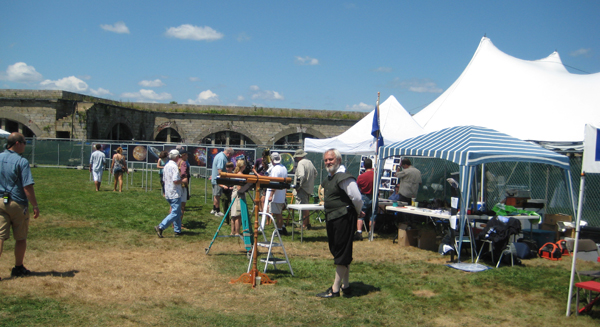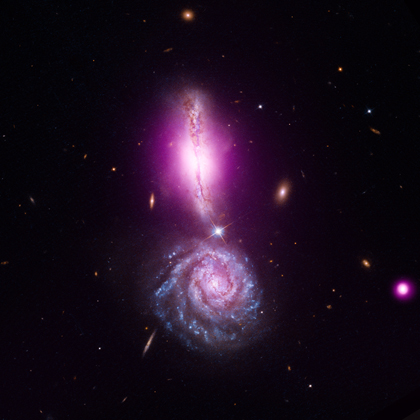Meet An Astronomy Intern: Jessica Brodsky
Submitted by chandra on Mon, 2011-09-12 10:47In this latest video blog, we sit down with Jessica Brodsky. Jessica is a student from Brown University who spent part of her summer doing detective work on the archive of Chandra images. Her task was to back fill the metadata into the Chandra images on chandra.si.edu. From her feedback, it was a useful experience, as Jessica's interests lie in digital assets management and web development. (We also heard that Jessica plans to take an astronomy course at Brown this year - awesome!).
Highest Energies in the Smallest State
Submitted by chandra on Wed, 2011-09-07 14:07This morning, the High Energy Astrophysics Division (aka HEAD) meeting kicks off in Newport, RI. What is this, you might ask? Well, the American Astronomical Society, or AAS, is the country’s largest professional group for astronomers. And because it is so large, they have also created several subdivisions so that scientists of a particular bent can gather to talk about their areas of interest.
NASA's Chandra Finds Nearest Pair of Supermassive Black Holes
Submitted by chandra on Wed, 2011-08-31 12:04Evidence for a pair of supermassive black holes in a spiral galaxy has been found in data from NASA's Chandra X-ray Observatory. This main image is a composite of X-rays from Chandra (blue) and optical data from the Hubble Space Telescope (gold) of the spiral galaxy NGC 3393. Meanwhile, the inset box shows the central region of NGC 3993 as observed just by Chandra.
Getting the Scoop on Space for Kids
Submitted by chandra on Wed, 2011-08-31 11:45This week, we're getting our foot in the door of an exciting new project. The European Southern Observatory has teamed up with the Universe Awareness project to produce kid-friendly versions of press releases on astronomy.

Meet an Astronomer: Joseph DePasquale
Submitted by chandra on Mon, 2011-08-22 11:12In this installment of our Meet An Astronomer video blog, we sit down with Joseph DePasquale. Joe is the Chandra science image processor who works hard to create the astronomy images that appear in press releases, on our web site, in print materials, and elsewhere. We think he has a pretty cool job, with a great combination of science and art.
-Kimberly Kowal Arcand, CXC
Meet An Astronomer: Julia Lee
Submitted by chandra on Tue, 2011-08-16 14:23Back by popular demand is our video blog series, Meet An Astronomer
Julia Lee is an associate professor in the astronomy department at Harvard. We caught up with Julia at a moment when she wasn't busy with her regular duties of running a research lab, teaching students, and everything else that a full-time position at a university like Harvard entails. Julia sat down with our "Meet an Astronomer" crew to explain how various choices she made led to her current career.
A Cosmic Exclamation Point
Submitted by chandra on Thu, 2011-08-11 10:55VV 340, also known as Arp 302, provides a textbook example of colliding galaxies seen in the early stages of their interaction. The edge-on galaxy near the top of the image is VV 340 North and the face-on galaxy at the bottom of the image is VV 340 South. Millions of years later these two spirals will merge - much like the Milky Way and Andromeda will likely do billions of years from now. Data from NASA's Chandra X-ray Observatory (purple) are shown here along with optical data from the Hubble Space Telescope (red, green, blue). VV 340 is located about 450 million light years from Earth.
Music Meets Astronomy at the Newport Folk Festival
Submitted by chandra on Mon, 2011-08-08 18:56Ever since we publicized the "deepest note in the Universe" in 2003, I have admired outreach efforts that combine music and astronomy. These efforts have continued this summer and fall with a program by Don Lubowich, from Hofstra University, who has organised astronomy exhibits to be installed at a large number of music festivals and events. My small role in this program involved displaying images from the "From Earth to the Universe (FETTU)" exhibit on the first day of the Newport Folk Festival at the end of July, added to Don's astronomy banners which also included material from FETTU.

A Birthday Card for Chandra
Submitted by chandra on Wed, 2011-07-27 12:33This is a slightly abridged version of a note that was recently sent around to the Chandra team by Harvey Tananbaum (Director of the Chandra X-ray Center) and Roger Brissenden (CXC Manager and Deputy Director of the Harvard-Smithsonian Center for Astrophysics) to congratulate everyone on Chandra’s 12th birthday. With the end of the Space Shuttle program just last week, it was a fitting reminder just that a short dozen years ago, Columbia blasted off carrying Chandra safely into orbit.
Pages
Please note this is a moderated blog. No pornography, spam, profanity or discriminatory remarks are allowed. No personal attacks are allowed. Users should stay on topic to keep it relevant for the readers.
Read the privacy statement






